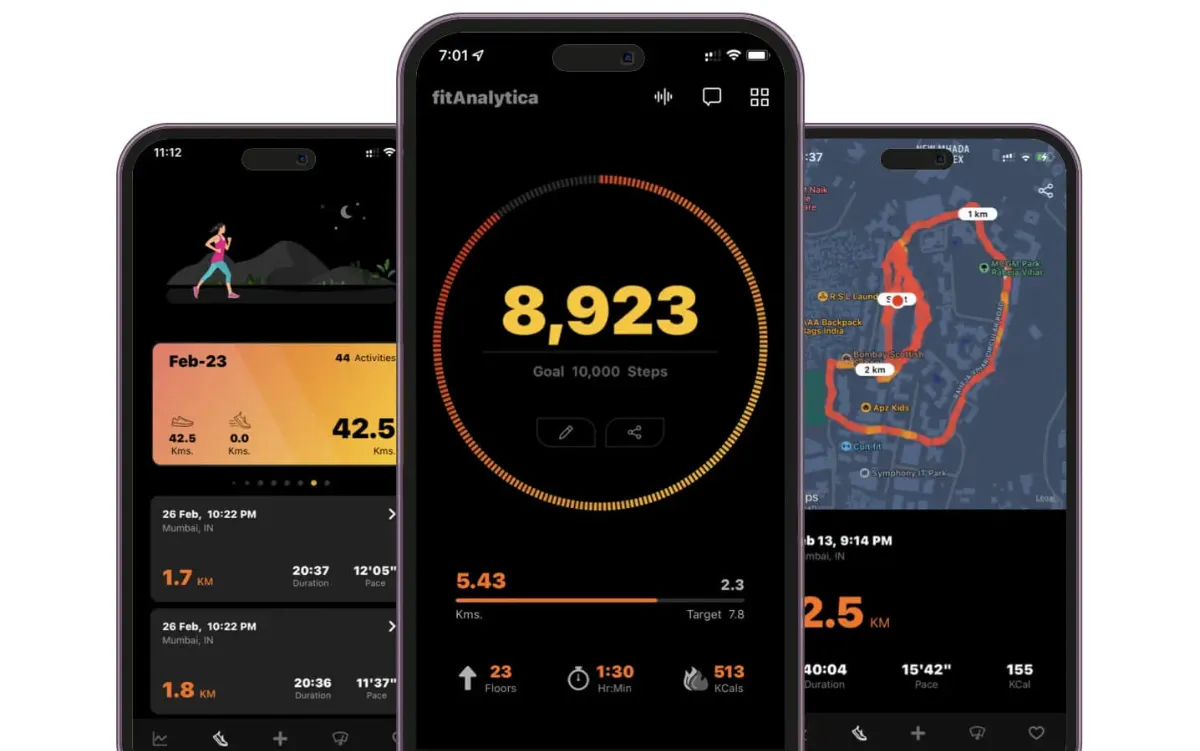Health benefits of walking
Walking is a straightforward yet valuable exercise with many health benefits and advantages. Here are some of the critical health benefits of incorporating a daily walk into your routine:
- Cardiovascular Health: Walking is an excellent method to enhance cardiovascular health. It helps strengthen your heart, increase circulation, improve blood pressure, reduce cholesterol levels, and mitigate the risk of heart disease and stroke.
- Weight Management: Walking is a low-impact aerobic exercise that can help you to lose weight. It burns calories, boosts metabolism, and helps maintain healthy body weight.
- Mental Well-Being: Walking positively affects mental health by reducing stress, anxiety, and depression. It stimulates the release of endorphins, which are natural mood lifters.
- Bone Strength: Engaging in weight-bearing exercises such as walking can enhance bone density and minimize the risk of osteoporosis as you age.
- Joint Health: Walking is gentle on the joints compared to high-impact exercise. It can improve joint flexibility and reduce the risk of joint-related issues.
- Muscle Tone: Walking engages various muscle groups, including the legs, buttocks, core, and back. Regular walking can help improve muscle tone and strength.
- Improved Digestion: Walking after meals can aid digestion by stimulating the digestive system and promoting efficient nutrient absorption.
- Boosted Immune System: Regular physical activity, including daily walking, can strengthen the immune system, making your body more resilient to infections.
- Better Sleep: Regular physical activity, such as daily walking, improves sleep quality by regulating your sleep-wake cycle, promoting deeper sleep.
- Enhanced Respiratory Health: Walking increases lung capacity and improves respiratory function, which benefits overall lung health.
- Diabetes Management: Walking helps manage blood sugar by balancing the insulin levels in your body
- Longevity: Research has shown that taking steps leads to a longer life and fewer chances of developing illnesses.
- Social Interaction: Walking is an excellent way to improve physical and mental health while socializing with friends, family, and neighbors.
- Cognitive Health: Regular walking improves cognitive function and decreases the risk of cognitive decline in older adults.
- Accessibility: One of the significant advantages of walking is that it's accessible to almost everyone, regardless of fitness level or age. It requires no special equipment and can be done anywhere.
To reap the benefits, aim for at least 150 minutes of moderate-intensity walking or 75 minutes of vigorous-intensity walking per week, as recommended by health guidelines. It is essential to begin your daily walk comfortably and slowly increase the length and intensity over time.
Steps to Calories Calculator
How can you increase your number of daily Steps To Calories?
Increasing your daily steps can be achieved through several simple strategies. Here are some simple ways to boost your step counts:
- Set a Goal: To monitor your progress, set a reasonable daily step goal and track using a smartphone app or pedometer.
- Take Short Walks: Use breaks at work or home to take short walks around your office, building, or neighborhood.
- Use Stairs: Opt for stairs instead of elevators, whenever possible, to add extra steps to your day.
- Park Farther: Park your car farther from your destination to add more walking before and after your activities.
- Walking Meetings: Conduct meetings or phone calls while walking to combine work with physical activity.
- Avoid Sitting for Long: It's essential to take out few minutes every hour to give your body a break and stretch your legs.
- Walk Errands: When running errands, walk or bike instead of driving, especially for short distances.
- Walk Pets: Ensure your furry friend gets enough exercise, so remember to take your dog for walks regularly.
- Morning or Evening Walks: Start or end your day with a brisk walk to set a positive tone or to unwind.
- Socialize on Foot: Suggest a walk together instead of meeting friends for coffee.
- Active Commuting: If feasible, walk or bike to work, or get off public transportation a few stops earlier.
- Gardening: Doing gardening tasks like weeding, planting, and watering can increase your step count.
- Dance: Put on some music and dance around your living room to have fun while being active.
- Use Phone Calls: A convenient method to boost your step count without interrupting your daily routine is to walk while engaging in a phone conversation. This habit will enhance the effectiveness and depth of your conversation.
- Take the Long Route: Choose longer routes or detours when walking from one place to another.
- Stretch Breaks: Incorporate stretches that involve movement, like leg swings or lunges, to add steps.
- Family Activities: Plan family outings that involve walking or hiking to make physical activity a shared experience.
- Track Progress: Regularly monitor your step count and celebrate milestones to stay motivated.
It's imperative to remember that small changes can significantly affect general health over time. Gradually implementing these strategies into your routine can dramatically increase exercise intensity and your daily step count, improving overall health and fitness.

Isn't walking too easy to be beneficial?
Despite its simplicity, walking offers many benefits that make it a precious form of exercise. Its low-impact nature makes it accessible to many individuals, including those recovering from injuries or seeking a gentle way to stay active. Though not as rigorous as other high-intensity exercises, it strengthens the heart, enhances blood circulation, and reduces the risk of health problems.
Walking aids in weight loss enhances mental well-being by releasing mood-elevating endorphins, and supports bone health by stimulating bone density. One of its remarkable features is its sustainability. Moreover, walking fosters joint flexibility, social interaction, and cognitive function. It is the starting point for beginners and a foundational component for maintaining overall health.

Factors affecting Steps To Calories burned when walking
Many factors play a role in determining the number of calories expended during a walk. It's important to note that these factors are interconnected and can impact each other's effects. Here are the key factors that affect the average number of calories burned:
- Weight: Heavier individuals spend more calories during the same activity than lighter individuals because they require more energy to move their body mass.
- Speed: Walking faster burns more calories per unit of time because you cover a greater distance and expend more energy.
- Distance: The longer you walk, the more calories you'll spend. Distance covered and calories consumed follow a linear relationship.
- Terrain: More energy is required when walking on slopes or uneven surfaces such as hills or trails, leading to spending more calories than walking on flat ground.
- Form and Style: Efficient walking technique can impact calorie burn. Engaging your arms, maintaining good posture, and taking full strides can contribute to increased energy spending.
- Metabolism: Individual metabolism varies. People with higher metabolism burns more calories at rest and during activity.
- Age: Metabolism tends to slow down with age, which can affect the rate at which you burn calories while walking.
- Gender: Typically, men have a higher muscle mass than women, which can cause a slight variation in the burn rate of calories. It is because muscles burn more calories than fat.
- Fitness Level: Regular exercisers tend to have more efficient cardiovascular systems, which can lead to burning more calories during activity.
- Clothing and Gear: Wearing heavy clothing and carrying a backpack or additional weight can increase calorie expenditure.
- Temperature: When exposed to extreme temperatures like freezing weather, your body has to work harder to maintain its temperature, resulting in higher burns.
- Interval Training: Incorporating short bursts of higher-intensity walking or intervals can elevate your heart rate, boost calorie burn, burn fat, and prevent cardiovascular disease.
- Health Conditions: Certain medical conditions or medications can affect metabolism and energy spending.
- Duration and Frequency: The total time you spend walking and how often you walk also influence the overall calorie you expend.
It's essential to remember that the number of calories burned walking is determined by various factors listed above, and individual differences can significantly impact it.

How Steps To Calories Calculator Works?
The underlying principle is that every step you take requires energy, and this same amount of energy can be converted into an estimated number of calories spent. It's important to note that while this is a basic calculation, the actual number can differ depending on individual factors.
Here's how a basic Steps to Calories calculator works:
<b>Calories per Step:</b> The calculator uses a predetermined value for calories burned per step. This value is often derived from research studies and averages. It's usually around 0.04 to 0.06 calories per step, though this can vary depending on your weight, walking speed, and other characteristics.
<b>Step Count:</b> You input the total number of steps you've taken during your walk. This can be tracked using a pedometer, fitness tracker, or smartphone app.
<b>Formula:</b> Multiply the number of steps you've taken by the estimated calories burned per step.
This calculation does not consider other factors affecting calorie burn, like metabolism, age, and overall fitness level.
Consider using a fitness tracker with a heart rate monitor for a more precise calorie burn estimate, especially if you're using walking as part of a fitness or weight loss plan. These devices account for heart rate, measuring more accurately energy expenditure.
Formula to convert height to step length
Converting height to step length involves a simple formula considering the average person's characteristics and walking habits. Here's a general walking formula you can use as a starting point:
The conversion factor for the step calculator can vary depending on gender, walking distance, speed, and personal gait. However, a commonly used approximation for step length is around 0.4 times the height.
So, the formula becomes:Step Length ≈ Height × 0.4
For example, if someone's height is 170 centimeters:Step Length ≈ 170 cm × 0.4 ≈ 68 centimeters
Please note that this formula only offers a general approximation. Actual step and stride length can vary based on individual biomechanics, walking speed, and other factors. If you want a more accurate calculation, measure your step length directly by walking a known distance and counting your steps.
Convert Kilometers, Miles, and Steps to Calories
Converting kilometers, miles, and steps to calories involves estimating the number of calories burned based on the distance covered and the number of steps taken. However, the accuracy of these conversions depends on factors like walking speed, weight, and individual metabolism. Here's a general guideline for the conversion:
<b>1. Kilometers to Calories:</b>
- On average, walking 1 kilometer burns around 30-40 calories, depending on factors like weight and pace.
- So, to convert kilometers to calories: Calories = Kilometers * 30-40 calories
<b>2. Miles to Calories:</b>
- On average, walking 1 mile burns around 80-100 calories, considering similar factors.
- To convert miles to calories: Calories = Miles * 80-100 calories
<b>3. Steps to Calories:</b>
- Steps can be converted to calories using an estimated 0.04 to 0.06 calories burned per step.
- To convert steps to calories: Calories = Steps * 0.04-0.06 calories
These are general estimates, and the actual calorie burn can vary significantly based on individual characteristics.

How many calories are burned per 1000 steps?
On average, each step burns around 0.04 to 0.06 calories. Let's use the mid-range of this estimate, which is 0.05 calories per step, for the calculation:
- Calories burned per step = 0.05 calories
- Number of steps = 1000 steps
- Calories burned = 0.05 calories/step * 1000 steps = 50 calories
<b>Approximately 1000 steps could burn around 50 calories.</b>
How many calories do 5,000 steps burn?
On average, each step burns around 0.04 to 0.06 calories. Let's use the mid-range of this estimate, which is 0.05 calories per step, for the calculation:
- Calories burned per step = 0.05 calories
- Number of steps = 5,000 steps
- Calories burned = 0.05 calories/step * 5,000 steps = 250 calories
<b>Approximately 5,000 steps could burn around 250 calories.</b>
How many calories do 10,000 steps burn?
The number of calories burned in 10,000 steps can vary depending on your weight, walking speed, and individual metabolism. On average, each step burns around 0.04 to 0.06 calories. Let's use the mid-range of this estimate, which is 0.05 calories per step, for the calculation:
- Calories burned per step = 0.05 calories
- Number of steps = 10,000 steps
- Calories burned = 0.05 calories/step * 10,000 steps = 500 calories
<b>Approximately 10,000 steps could burn around 500 calories.</b>
However, keep in mind that this is a general estimate. The actual calorie burn can vary based on factors specific to you, such as your weight, average walking speed used, and individual metabolism.
How many calories do 15,000 steps burn?
On average, each step burns around 0.04 to 0.06 calories. Let's use the mid-range of this estimate, which is 0.05 calories per step, for the calculation:
- Calories burned per step = 0.05 calories
- Number of steps = 15,000 steps
- Calories burned = 0.05 calories/step * 15,000 steps = 750 calories
<b>Approximately 15,000 steps could burn around 750 calories.</b>
If you're using walking for specific fitness or achieving weight loss goals, consider using a fitness tracker with a heart rate monitor for a more accurate measurement of calorie burn.
How many calories do 20,000 steps burn?
On average, each step burns around 0.04 to 0.06 calories. Let's use the mid-range of this estimate, which is 0.05 calories per step, for the calculation:
- Calories burned per step = 0.05 calories
- Number of steps = 20,000 steps
- Calories burned = 0.05 calories/step * 20,000 steps = 1000 calories
<b>Approximately 20,000 steps could burn around 1000 calories.</b>
If you're using walking for specific fitness or achieving weight loss goals, consider using a fitness tracker with a heart rate monitor for a more accurate measurement of calorie burn.

How many steps burn 1 calorie?
On average, a person with a healthy diet burns 1 calorie by taking 20 steps. This is a general approximation, and the actual number of steps required to burn 1 calorie can vary based on factors like walking speed, metabolism, weight, and individual variations.
Remember that this is a simplified calculation and that the relationship between steps and calorie burn is not linear. The number of steps needed to spend specific calories can change depending on how fast you're walking, your body composition, and other factors.
How many steps burn 500 calories?
To estimate how many steps are needed to burn 500 calories, we can use the average range of around 0.04 to 0.06 calories per step. For this calculation, We will use the mid-range of this estimate, which is 0.05 calories per step.
Let's set up the equation:
- Calories burned per step = 0.05 calories
- Calories to burn = 500 calories
- Number of steps = Calories to burn / Calories burned per step
- Number of steps = 500 / 0.05 = 10,000 steps
<b>Approximately 10,000 steps could burn around 500 calories.</b>
How many steps burn 1000 calories?
To estimate how many steps are needed to burn 1000 calories, we can again use the average range of calories burned, around 0.04 to 0.06 calories per step. For this calculation, we will use the mid-range of this estimate, which is 0.05 calories per step.
Let's set up the equation:
- Calories burned per step = 0.05 calories
- Calories to burn = 1000 calories
- Number of steps = Calories to burn / Calories burned per step
- Number of steps = 1000 / 0.05 = 20,000 steps
<b>Approximately 20,000 steps could burn around 1000 or more calories.</b>
However, this is a rough estimate of the calorie burn during a walk.

How many calories do you burn in a 30-minute walk?
The number of calories burned can differ depending on the person's weight, average pace of walking, and individual metabolism. An average person can burn around 3.5 to 7 calories per minute while walking. Let's use the mid-range of this estimate, which is 5.25 calories per minute, for the calculation:
- Calories burned per minute = 5.25 calories
- Duration of walk = 30 minutes
- Calories burned = Calories burned per minute × Duration of walk
- Calories burned = 5.25 calories/minute × 30 minutes = 157.5 calories
<b>A 30-minute walk could burn around 157.5 calories.</b>
How many calories do you burn in a 60-minute walk?
The number of calories burned during a 60-minute walk can vary based on weight, walking speed, and individual metabolism. To provide a rough estimate, we will use a general average range of calories burned per minute of brisk walking and then multiply it by 60 minutes.
An average person can burn around 3.5 to 7 calories per minute while walking. Let's use the mid-range of this estimate, which is 5.25 calories per minute, for the calculation:
- Calories burned per minute = 5.25 calories
- Duration of walk = 60 minutes
- Calories burned = Calories burned per minute × Duration of walk
- Calories burned = 5.25 calories/minute × 60 minutes = 315 calories
<b>A 60-minute walk could burn around 315 calories.</b>
Does stepping side-to-side burn calories?
Yes, stepping side to side can indeed burn calories. This lateral movement engages different muscles than forward walking, making it a valuable addition to your fitness routine. Side Walking, also known as Crab Walking, targets muscles such as the hip abductors, adductors, quadriceps, and glutes.
Crab Walking requires these muscles to work against resistance, which burns calories. Additionally, lateral movements can enhance your overall agility and balance. Incorporating side steps into your exercise routine can provide a well-rounded workout by engaging muscle groups that might not be as active during traditional forward walking or running.
As with any exercise, the number of calories burned depends on various factors, including your weight, the intensity of the movement, and the duration of your workout. If you want to diversify your calorie-burning routine, incorporating Crab Walking is a great choice.
What's the Step Count to Shed a Pound of Fat?
It takes roughly 3,500 calories to constitute a pound of fat. You'd need to accumulate between 70,000 to 77,000 steps to shed a pound of fat. Simply, walking around 11,500 steps daily for a week would equal burning off one pound of fat.

Calorie Burned using Metabolic Equivalent of Task (MET)
Calculating calorie burn using MET is a method to estimate energy or caloric expenditure during physical activities. MET represents the ratio of energy expended during an activity to the energy expended at rest. It provides a standardized way to compare the intensity of different activities.
To calculate calories burned using MET, you need three key parameters:
- MET value of the activity,
- Individual's body weight, and
- Duration of the activity in hours
<b>The formula for the metabolic equation is</b>
MET values vary based on the activity's intensity. Lower MET values correspond to lighter activities like sitting, while higher MET values indicate more strenuous activities like running. By selecting the appropriate MET value for an activity, you can quantify the energy expenditure accurately. Our steps to Calories calculator below uses MET for calorie spending calculation.
How to Use Our Steps to Calories Calculator?
The Steps to Calories Calculator is very straightforward to use. Follow these instructions: :
- Select your activity type (slow walk, fast walk, slow running, fast running, sprinting).
- Slide to enter your body weight
- Slide to enter your step count
- Boom! Steps to Calories Calculator shows your live result
Interpreting your Steps to Calories Calculator Results
The outcome estimates the calories expended based on the designated quantity of steps. This calculation supplements your usual daily calorie consumption, which encompasses your Basal Metabolic Rate (BMR), the Thermal Effect of Food (TEF), and the Thermal Effect of Activity (TEA).
Increase your daily steps to spend more calories in a day. Input different step counts until you arrive at the number of calories you want to spend.
How fitAnalytica calculates energy burnt during an activity?
While on the web, we have many steps to calories calculator; fitanalytica employs a sophisticated algorithm to estimate the energy expended during various activities accurately. Our algorithm goes beyond simple calculations by predicting the specific type of activity a user engages in. This prediction is based on data points such as motion patterns, heart rate, and user input.
Once the algorithm identifies the activity, it accesses a database of MET (Metabolic Equivalent of Task) values associated with different activities. MET values represent the energy spent by an individual performing an activity relative to their resting metabolic rate.
By matching the predicted activity to its corresponding MET value, fitAnalytica precisely quantifies the energy burned during that specific activity. This approach ensures that the estimation is tailored to the activity's intensity and characteristics, providing a more accurate representation of the user's effort.
This a free steps to calories calculator help you to estimate the number of calories you burn by walking. Our goal is to empower individuals with reliable and insightful information about their physical exercise, like steps walked, walking time, distance traveled, elevation gain/lost, and calories burned. It helps users spend extra calories and lose excess body fat.

Conclusion: Should you track calories burned during an activity?
Monitoring the calories people burn through exercise can provide valuable insights and motivation. While the numbers aren't the sole indicators of success, they offer a measurable way to understand the impact of your efforts. Here's why considering calorie tracking can be a smart move:
<b>Precision in Progress:</b> Tracking calories burned gives you a clear picture of the energy expenditure associated with different exercises. This awareness can help you fine-tune your workouts and choose activities that align with your fitness goals.
<b>Informed Decision-making:</b> Armed with the knowledge of how many calories you have burned during a walk, you can make informed choices about your exercise routine. You'll be better equipped to balance your calorie intake and expenditure, which is crucial for losing weight.
However, it's important to remember that calorie tracking or creating a calorie deficit is just one tool in your wellness toolbox. Balancing exercise with a nutritious diet, getting enough rest, and listening to your body is equally important. Additionally, don't let the numbers dictate your self-worth or enjoyment of physical activity. The journey towards better health is multifaceted, and while numbers provide valuable insights to build an average pace of daily calorie spend, they don't define your entire progress.
So, as you lace up your shoes and embark on your fitness journey, consider using our steps to calories calculator as a guiding star. Let it help you make informed decisions, set achievable goals, and celebrate your triumphs. Ultimately, your well-being is a holistic endeavor beyond numbers, embracing the joy and empowerment of taking charge of your health.
